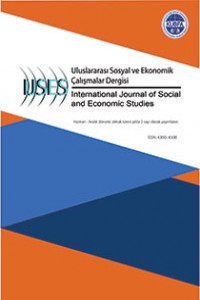Türkiye’de Kadın İstihdamının Görünümü: Kadın İstihdamı ile FBGSYH, Enflasyon Oranı ve Kadın İşgücü Oranı Arasındaki Eştümleşme İlişkisinin Araştırılması
Dünya nüfusunun yarısını kadınların oluşturduğu düşünüldüğünde kadınların istihdamda yer alması ülkelerin büyüyebilmesi ve kalkınması için gereklidir. Zira kadınların desteği olmadan ülkeler potansiyel büyüme hızlarına ulaşamayacaktır. Türkiye’de kadın istihdamı OECD ülkeleri ile kıyaslandığında çok daha düşük kalmaktadır. Çalışmanın amacı, Türkiye’de kadın istihdamının temel ekonomik göstergelerden nasıl etkilendiğini ortaya koymaktır. Bu çalışmada TÜİK, DataBank ve OECD Data verileri kullanılarak kadın istihdamının Türkiye’deki görünümü ortaya konmuş; Türkiye’de 1988-2019 yılları arasında kadın istihdam oranı ile fert başına düşen gelir, kadın işgücü oranı ve enflasyon oranı arasındaki ilişki eştümleşme yöntemiyle analiz edilmiştir.
Anahtar Kelimeler:
İstihdam, Kadın İstihdamı, Kadın İşgücü, İstihdam, Kadın İstihdamı, Kadın İşgücü
___
- Akkuş, E. (2012). Phillips Eğrisi: Enflasyon- İşsizlik Değiş-Tokuşu Teorik Bir İnceleme. İstanbul Üniversitesi İktisat Fakültesi Mecmuası , 62 (2), 99-151.
- Anyanwu, J. C., & Augustine, D. (2013). Towards Inclusive African Labour Market: Empirical Analysis Of Gender Equality In Employment and its Implications for Policy. African Development Bank Working Paper , s. 1-33.
- Boserup, E. (1970). Women's Role in Economic Development. New York: St. Martin's Press.
- Charemza, W., & Deadman, D. (1992). New Directions ln Econometric Practice. England: Edward Elgar.
- Dickey, D., & Fuller, W. A. (1981). Likelihood Ratio Statistics for Autoregressive Time Series with a Unit Root. Econometrica , 49 (4), 1057-1073.
- Engle, R. F., & Granger, C. W. (1987). Cointegration and Error Correction: Representation, Estimation and Testing. Econometrica , 251-276.
- Goldin, C. (1995). The U-Shaped Female Labor Force Function in Economic Development and Economic History. T. P. Schultz içinde, Invesment in Women's Human Capital. Chicago: The University of Chicago Press.
- Göcen, S. (2020). Ekonomik Gelişme ve Kadın İş Gücü İstihdamı: Türkiye İçin Nedensellik İlişkisi İncelenmesi. Uluslararası İktisadi ve İdari İncelemeler Dergisi , 45-60.
- Gregory, A. W., & Hansen, B. E. (1996). Residuals-based tests for cointegration in models with regime shifts. Journal of Econometrics , 70 (1), 99-126.
- Güçlü, M. (2018). Ekonomik Kalkınma ve Kadınların İşgücüne Katılımı: Türkiye İçin U Hipotezinin Yeniden Test Edilmesi. Pamukkale Üniversitesi Sosyal Bilimler Enstitüsü Dergisi , 203-210.
- İlker Şirin, Tuğçe Güzel. (2020). Sigortalı Kadınların Doğum Sonrası İşe Dönüş Süreleri İçin Sağkalım Analizi Uygulaması. Mediterranean Journal of Humanities , 449-458.
- İzolluoğlu, C. (2019). Zaman Serisi Birim Kök Testleri ve Bir Uygulama. Yüksek Lisans Tezi . Malatya: T.C. İnöünü Üniversitesi Sosyal Bilimler Enstitüsü.
- Johansen, S. (1988). Statistical Analysis of Cointegration Vectors. Journal of Economic Dynamics and Control , 12 (2-3), 231-254. Kadının Statüsü Genel Müdürlüğü. (2018). Kadının Güçlenmesi Strateji Belgesi ve Eylem Planı. Ankara: T.C Aile ve Sosyal Politikalar Bakanlığı.
- Kwiatkowski, D., Phillips, P. C., Schmidt, P., & Shin, Y. (1992). Testing the null hypothesis of stationarity against the alternative of a unit root How sure are we that economic time series have a unit root?*. Journal of Econometrics , 54, 159-178.
- MacKinnon, J. G. (2010). Critical values for cointegration tests. (1227) , 1-17. (Q. U. Economics, Dü.) Kingston (Ontario).
- MacKinnon, J. G., White, H., & Davidson, R. (1983). Tests for Model Specification in The Presence of Alternative Hypotheses: Some Further Results. Journal of Econometrics , 21 (1), 53-70.
- Niemi, B. T., & Lloyd, C. B. (1981). Female Labor Supply in the Context of Inflation. American Economic Review , 71 (2), 70-75. OECD. (tarih yok). LFS by sex and age - indicators. Temmuz 2, 2021 tarihinde OECD.Stat: https://stats.oecd.org/viewhtml.aspx?datasetcode=LFS_SEXAGE_I_R&lang=en# adresinden alındı
- Okun, A. (1962). Potential GNP & Its Measurement and Significance. American Statistical Association, Proceedings of the Business and Economics Statistics Section , 98-104.
- Önel, G. (tarih yok). Uzun Dönem, Ekonomi Teorisi ve Koentegrasyon.
- Özkök, C. S., & Polat, M. A. (2020). Ekonomik Büyüme, Enflasyon ve Kentleşmenin Kadınların İşgücüne Katılımına Etkileri: Türkiye Üzerine Uygulama. Küresel İktisat ve İşletme Çalışmaları Dergisi , 9 (17), 63-76.
- Phillips, P., & Hansen, B. (1990). Statistical Inference in Instrumental Variables Regression with I(1) Processes. Review of Economic Studies , 99-125.
- Phillips, P., & Perron, P. (1988). Testing for a Unit Root in Time Series Regression. Biometrica , 75 (2), 335-346.
- Phillips, W. A. (1958). The Relation Between Unemployment and the Rate of Change of Money Wage Rates in the United Kingdom, 1861–1957. Economica , 25 (2), 283-299.
- Psacharopoulos, G., & Tzannatos, Z. (1989). Female Labor Force Participation: An International Perspective. World Bank Research Observer , 187-201.
- Samuelson, P. A., & Solow, R. M. (1960). Problem of Achieving and Maintaining a Stable Price Level: Analytical Aspects of Anti-Inflation Policy. The American Economic Review , 50 (2), 177-194.
- Selin Umutlu, Mustafa Öztürk. (2020). İş Yaşamında Kadın ve Karşılaştığı Sorunlar. Süleyman Demirel Üniversitesi İktisadi ve İdari Bilimler Fakültesi Dergisi , 297-306.
- Tam, H. (2010). U-Shaped Female Labor participation with Economic Development: Some Panel Data Evidence. Economics Letters , 140-142.
- Tansel, A. (2001, Aralık). Economic Development and Female Labor Force Participation in Turkey:Time-Series Evidence and Cross-Province Estimates. METU/ ERC Working Paper No.02/3 , s. 1-61.
- The World Bank. (tarih yok). DataBank World Development Indicators. 07 02, 2021 tarihinde DataBank: https://databank.worldbank.org/source/world-development-indicators# adresinden alındı
- Thévenon, O. (2013, 05 23). Drivers of Female Labour Force Participation in the OECD. OECD Social, Employment and Migration Working Papers No.145 , s. 1-57.
- TÜİK. (tarih yok). 07 02, 2020 tarihinde https://www.tuik.gov.tr/ adresinden alındı
- Utkulu, U., & Önel, G. (2006). Modeling the long-run sustainability of Turkish external debt with structural changes. Economic Modelling , 1-14.
- Zeren, F., & Savrul, B. K. (2017). Kadınların İşgücüne Katılım Oranı, Ekonomik Büyüme, İşsizlik Oranı ve Kentleşme Oranı Arasındaki Saklı Koentegrasyon İlişkisinin Araştırılması. Yönetim Bilimleri Dergisi , 15 (30), 87- 103. Zivot, E., & Andrews, D. W. (1992). Further Evidence on the Great Crash, the Oil-Price Shock, and the Unit-Root Hypothesis. Journal of Business & Economic Statistics , 10 (3), 251-270.
- Başlangıç: 2020
- Yayıncı: Kütahya Dumlupınar Üniversitesi
